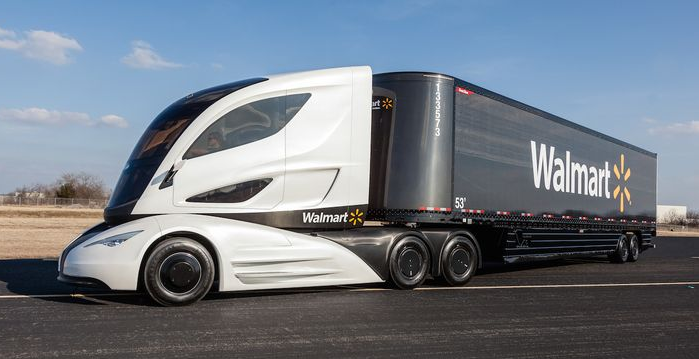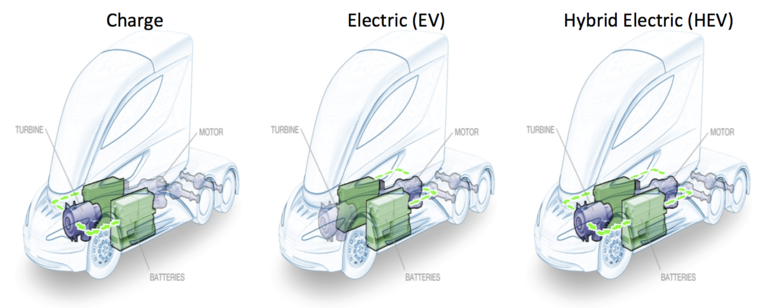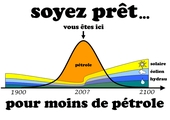In my previous posts, I made you out the importance of also electrify heavy trucks, given their important role in our oil consumption in Quebec. I recently updated my lecture Driving without oil, and I took the opportunity to make a new graph showing the state of the situation, 2011, for all transport sectors in Quebec. If we consider only road transport, heavy trucks account 25% of oil consumption in 2011 Quebec.
I already told you what I thought best for gradually electrify heavy trucks, a group of electric traction extender. By recharging a battery of 100 km range overnight fast and two refills (10 minutes) on the day 300 km per day is achieved in electric mode. In 10 years, reducing the weight and cost of the batteries we can do 600 km electricity or 800 3 km with quick refills.
We must therefore develop electric traction groups extender (also called series hybrid systems).

This is what a group of companies has just done to deliver the WAVE semi-trailer truck to Walmart, which is part of this company's efforts to reduce their fuel consumption and the maintenance of their truck fleet. A fine example of synergy between the economy and the environment. See
http://www.greencarcongress.com/2014/03 ... -wave.html
and the video on Youtube
http://www.youtube.com/watch?list=UUT5J ... ER9X4_gtYk
The airfoil is also made possible through the use of a microturbine as a range extender, which does not require liquid cooling, so no big radiator in front of the tractor. Furthermore, the small size of this microturbine allows to place it under the cockpit, with the electric motor and batteries, while enabling the narrow profiling of the cabin, which adds to the tractor aerodynamics. The tractor-trailer combination thus provides 20% less resistance to the flow of air, which results in a reduction of 10% of the fuel consumption.
Walmart and its partners do not provide consumption figures of the semitrailer truck WAVE, but I'll estimate. Hybridization normally reduces the consumption of a truck 10 25% to% as we drove on highways or in urban areas. The important relief resulting from the extensive use of carbon fiber (almost 2 tonnes less for the trailer) could result in a 5% less consumption.
45,5 kwh battery of the tractor should allow a range of about 50 km in electric mode, which also contributes to fuel consumption reduction. For cons, the effectiveness of a microturbine is 30% (30% of the chemical energy contained in the fuel is converted into mechanical energy), while a heavy piston diesel engine achieves about 40% of 'efficiency. There is therefore a reduction in efficiency caused by the microturbine 25%. It consumes diesel but it would work well with natural gas or biomethane, or biodiesel (made from recycled fat where biosynthetic).
Let's balance sheet. There is a loss of 25% efficiency due to the use of a microturbine. By one gains against 10% with better aerodynamics, and say of 15% due to hybridization. Besides the reduction in weight possibly brings us another 5% gain. Now, assuming a daily mileage of 500 km and a single charge per day, the autonomy of 50 km in electric mode means another gain 10% (which could be increased significantly by increasing the capacity of the battery and recharging three times a day). Experimental short trailer truck WAVE, as it now should consume about 15% less diesel fuel than a conventional semi-trailer truck.
But we must not only look at fuel consumption. We must also take into account the fact that one does not need elaborate cooling system (cooling air is required) or after combustion gas treatment system (less pollution, even without catalysts or filters particles nor urea injection system). Otherwise the microturbine has only one moving part that operates with air-cushion bearings and do not require lubrication. So there was no oil changes to be performed. Finally there is also no EGR valve (Exaust gas recovery) or turbo intercooler neither. In short, there is MUCH LESS maintenance, which results in a substantial reduction in operating costs.
In terms of modes of functioning of the traction unit, there are three: the CHARGE MODE The POWER MODE, and the HYBRID MODE.

In the charging mode, if a charging station is not within reach, the microturbine recharge the batteries while the truck is stopped. In the electric mode, the electric motor is powered only by batteries. When their charge level reaches 50%, the microturbine starts automatically and always runs at its optimal regime, where fuel consumption is minimal. In hybrid mode, the microturbine constantly recharges the batteries, by the way, always turning at its optimum speed.
It's very exciting to see the momentum of the electrification of transport grow, even for heavy trucks!
Sincerely
Pierre Langlois, Ph.D., physicist


